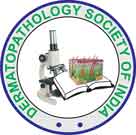Answer to Image of the Month August 2014
Submitted by Achyut Pokharel
Hailey-Hailey disease
Hailey disease or familial benign pemphigus is an autosomal dominant disorder with incomplete penetrance. Approximately two thirds of patients have a family history of the disorder. A history of multiple relapses and remissions is characteristic. Many hypotheses exist concerning the pathogenesis of the disease, but the cause remains uncertain. An overall defect in keratinocyte adhesion appears to be due to a defect in the calcium pump protein, ATP2C1.
Vesicles and erythematous plaques with overlying crusts typically occur in the skin folds and neck region. Burning and itching accompany the eruption, and a malodorous drainage occurs in some cases as a result of secondary infection. The characteristic clinical appearance of familial benign pemphigus, as well as biopsy findings, readily confirms the diagnosis. Familial benign pemphigus waxes and wanes in intensity. Topical corticosteroids and antibiotics along with emollients are the mainstay of treatment. A recent report documented use of narrow-band ultraviolet B phototherapy.
This patient is a 33-year-old male. He has erythematous, crusted and eroded plaques in the axillae and neck folds. Other members of his family are similarly affected. He was treated with topical steroid and antibiotics with which the condition improves, but recurrences are frequent.
